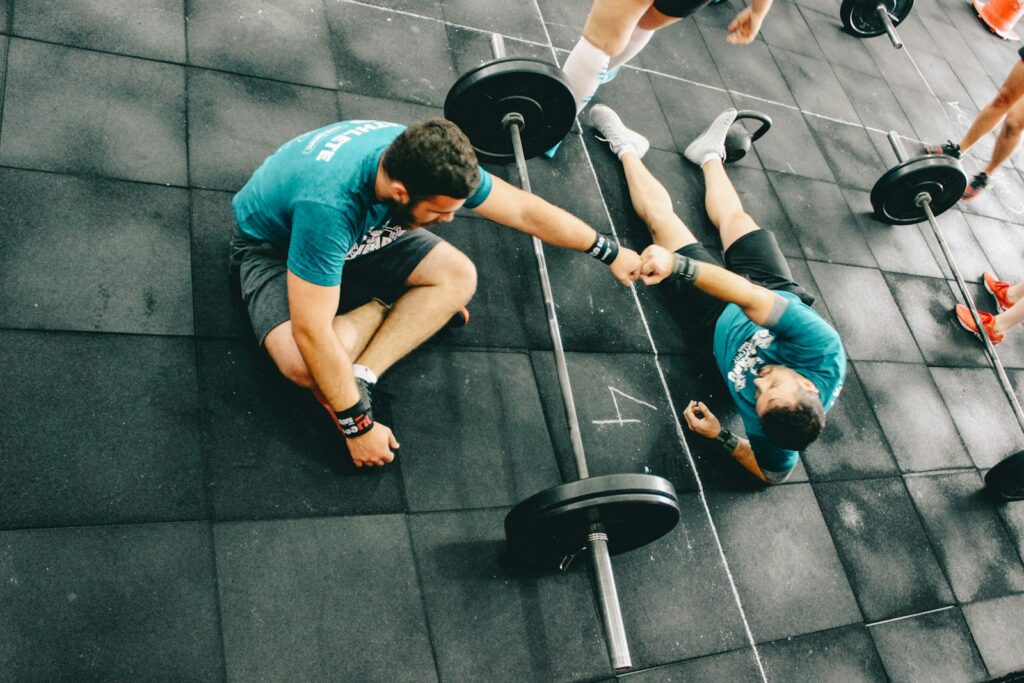Hey, this is Sho!
In CrossFit and functional fitness, low-weight, high-rep training is a common approach. While high-weight, low-rep training is often considered the best for strength gains, low-weight, high-rep training has unique benefits, particularly for muscular endurance and hypertrophy.
In this article, we’ll explore how low-weight, high-rep training affects muscle stress, its benefits, and effective workout strategies.

What is Low-Weight, High-Rep Training?
Low-weight, high-rep training involves using lighter loads (typically 40-60% of 1RM) and performing more than 15 reps per set. It’s commonly used in CrossFit WODs (Workout of the Day) and bodybuilding-style pump training.
Examples of Low-Weight, High-Rep Workouts:
- Barbell squats, deadlifts, or bench press (40-50% 1RM for 20 reps)
- Dumbbell bench press (15 reps) → Shoulder press (15 reps) in a superset
- Kettlebell swings or wall ball shots for high reps
Unlike high-weight, low-rep training, this method is more focused on muscular endurance and metabolic stress, making it effective for improving localized muscular stamina.

How Low-Weight, High-Rep Training Affects Muscle Stress
1. Metabolic Stress
High-rep training results in lactate accumulation and metabolic byproducts, which stimulate growth hormone release and contribute to muscle hypertrophy.
⚠ However, be cautious:
- High-intensity CrossFit WODs can push heart rate into Zone 4 (above 80% max heart rate), leading to muscle catabolism (breakdown).
- To maximize hypertrophy, avoid excessive heart rate spikes and maintain moderate intensity.
- Use controlled rest periods and consistent movement pacing to balance endurance and hypertrophy.
2. Mechanical Tension
While low-weight training applies less mechanical tension than heavy lifting, repeated contractions still generate sufficient stress for muscle adaptation.
- It’s effective for improving muscular endurance and Type I (slow-twitch) muscle fibers.
- For strength gains, however, incorporating moderate-to-heavy loads (around 5RM) is essential.
about strength gain, please read this article.
Optimal Sets and Frequency for Muscle Growth and Strength: Research-Based
3. Time Under Tension (TUT)
A major benefit of high-rep training is increased time under tension (TUT).
For example:
- 10 reps of squats may take 30 seconds, while 20 reps take 60 seconds → More TUT = More stimulus for endurance and hypertrophy.
Research also supports TUT as a factor in muscle growth, making this method effective for both endurance athletes and bodybuilders.
Benefits of Low-Weight, High-Rep Training
1. Muscle Hypertrophy (Sarcoplasmic Growth)
- Primarily increases muscle size by expanding the sarcoplasm (fluid within muscle cells).
- Enhances muscle fullness and definition—commonly used by bodybuilders pre-competition.
- Read more about hypertrophy [here].
2. Faster Recovery
- Lower joint and nervous system stress compared to heavy lifting.
- Enables higher training frequency while reducing injury risk.
3. Ideal for Endurance-Based Sports
- Improves stamina for sports like running, cycling, and CrossFit.
- Great for athletes requiring sustained muscular endurance.

Best Low-Weight, High-Rep Training Examples
Chest Workouts
- Barbell bench press (40-50% 1RM, 15-20 reps)
- Incline dumbbell press (15-20 reps)
- Push-ups (high reps, bodyweight)
- Rest: 30-45 seconds between sets
Back Workouts
- Lat pulldown (40% 1RM, 20-25 reps)
- Bent-over rows (50% 1RM, 15-20 reps)
- Seated rows (high reps)
- Rest: 30-45 seconds between sets
Lower Body Workouts
- Back squat (Front squat or goblet squat alternative) (40-50% 1RM, 15-20 reps)
- Bulgarian split squat (15-20 reps per leg)
- Leg extensions (20-25 reps)
- Rest: 30-60 seconds depending on intensity
Conclusion
Low-weight, high-rep training is highly effective for improving endurance, hypertrophy, and recovery.
To optimize your training:
- Combine both high-rep and low-rep training for balanced results.
- Use controlled intensity to prevent excessive fatigue.
- Adjust volume and rest periods based on goals (hypertrophy vs endurance).
By integrating this method, you can maximize muscle growth, endurance, and overall performance. Try incorporating it into your next training cycle!

Pingback: CrossFit Beginners: Master Form for Faster Progress